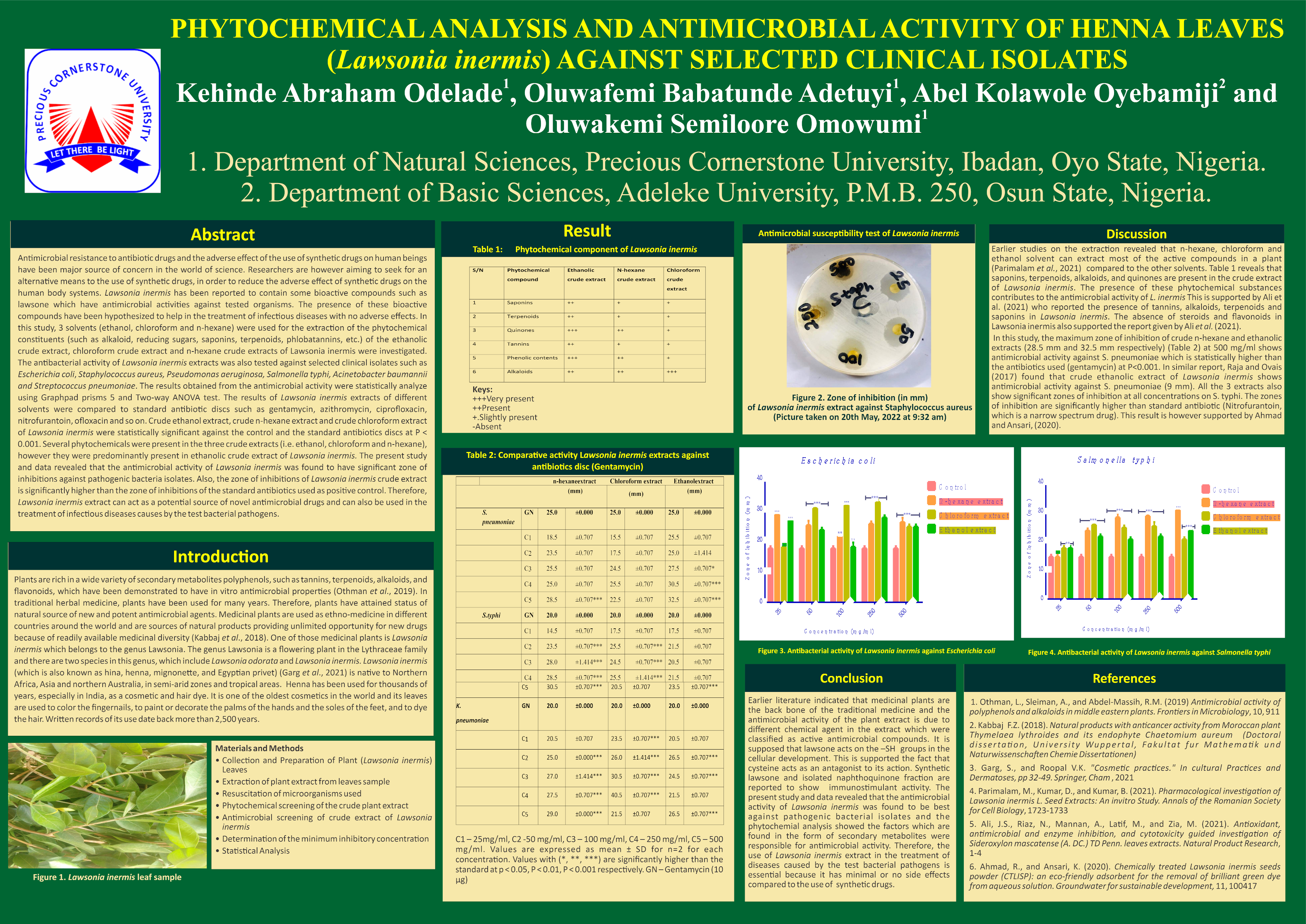Oluwakemi S. Omowumi
Conference 2023 Presentation
Project title
PHYTOCHEMICAL ANALYSIS AND ANTIMICROBIAL ACTIVITY OF HENNA LEAVES (LAWSONIA INERMIS) AGAINST SELECTED CLINICAL ISOLATES
Authors and Affiliations
Odelade Kehinde Abraham1, Oyebamiji Abel Kolawole2, Adetuyi Babatunde Oluwafemi1 and Omowumi Oluwakemi Semiloore1
1. Department of Natural Sciences, Precious Cornerstone University, Ibadan, Nigeria
2. Department of Basic Sciences, Adeleke University, P.M.B. 250, Osun State, Nigeria
Abstract
Background
Antimicrobial resistance to antibiotic drugs and the adverse effect of the use of synthetic drugs on human beings have been major source of concern in the world of science. Researchers are however aiming to seek for an alternative means to the use of synthetic drugs, in order to reduce the adverse effect of synthetic drugs on the human body systems. Lawsonia inermis has been reported to contain some bioactive compounds such as lawsone which have antimicrobial activities against tested organisms. The presence of these bioactive compounds have been hypothesized to help in the treatment of infectious diseases with no adverse effects
Methods
In this study, 3 solvents (ethanol, chloroform and n-hexane) were used for the extraction of the phytochemical constituents (such as alkaloid, reducing sugars, saponins, terpenoids, phlobatannins, etc.) of the ethanolic crude extract, chloroform crude extract and n-hexane crude extracts of Lawsonia inermis were investigated. The antibacterial activity of Lawsonia inermis extracts was also tested against selected clinical isolates such as Escherichia coli, Staphylococcus aureus, Pseudomonas aeruginosa, Salmonella typhi, Acinetobacter baumannii and Streptococcus pneumoniae.The results obtained from the antimicrobial activity were statistically analyze using Graphpad prisms 5 and Two-way ANOVA test.
Results
The results of Lawsonia inermis extracts of different solvents were compared to standard antibiotic discs such as gentamycin, azithromycin, ciprofloxacin, nitrofurantoin, ofloxacin and so on. Crude ethanol extract, crude n-hexane extract and crude chloroform extract of Lawsonia inermis were statistically significant against the control and the standard antibiotics discs at P < 0.001.
Conclusions
Several phytochemicals were present in the three crude extracts (i.e. ethanol, chloroform and n-hexane), however they were predominantly present in ethanolic crude extract of Lawsonia inermis. The present study and data revealed that the antimicrobial activity of Lawsonia inermis was found to have significant zone of inhibitions against pathogenic bacteria isolates. Also, the zone of inhibitions of Lawsonia inermis crude extract is significantly higher than the zone of inhibitions of the standard antibiotics used as positive control. Therefore, Lawsonia inermis extract can act as a potential source of novel antimicrobial drugs and can also be used in the treatment of infectious diseases causes by the test bacterial pathogens.

